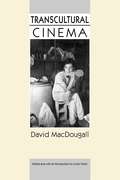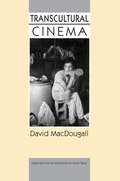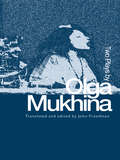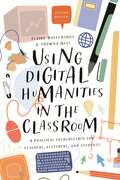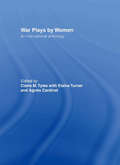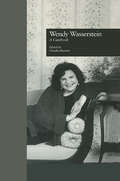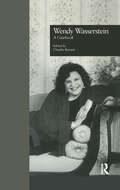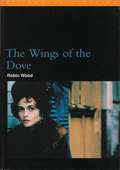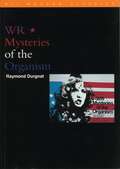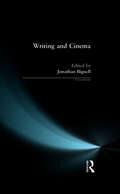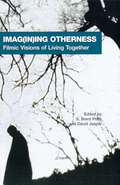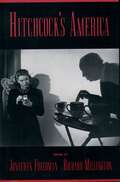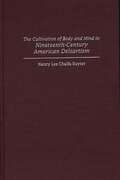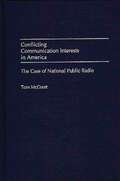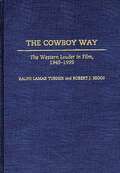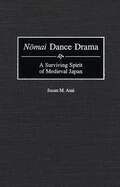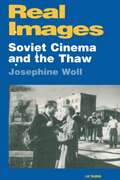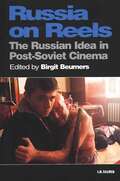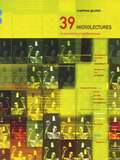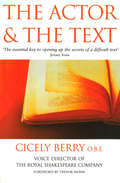- Table View
- List View
Transcultural Cinema
by David Macdougall Lucien TaylorDavid MacDougall is a pivotal figure in the development of ethnographic cinema and visual anthropology. As a filmmaker, he has directed in Africa, Australia, India, and Europe. His prize-winning films (many made jointly with his wife, Judith MacDougall) include The Wedding Camels, Lorang's Way, To Live with Herds, A Wife among Wives, Takeover, PhotoWallahs, and Tempus de Baristas. As a theorist, he articulates central issues in the relation of film to anthropology, and is one of the few documentary filmmakers who writes extensively on these concerns. The essays collected here address, for instance, the difference between films and written texts and between the position of the filmmaker and that of the anthropological writer.In fact, these works provide an overview of the history of visual anthropology, as well as commentaries on specific subjects, such as point-of-view and subjectivity, reflexivity, the use of subtitles, and the role of the cinema subject. Refreshingly free of jargon, each piece belongs very much to the tradition of the essay in its personal engagement with exploring difficult issues. The author ultimately disputes the view that ethnographic filmmaking is merely a visual form of anthropology, maintaining instead that it is a radical anthropological practice, which challenges many of the basic assumptions of the discipline of anthropology itself. Although influential among filmmakers and critics, some of these essays were published in small journals and have been until now difficult to find. The three longest pieces, including the title essay, are new.
Transcultural Cinema
by David MacDougallDavid MacDougall is a pivotal figure in the development of ethnographic cinema and visual anthropology. As a filmmaker, he has directed in Africa, Australia, India, and Europe. His prize-winning films (many made jointly with his wife, Judith MacDougall) include The Wedding Camels, Lorang's Way, To Live with Herds, A Wife among Wives, Takeover, PhotoWallahs, and Tempus de Baristas. As a theorist, he articulates central issues in the relation of film to anthropology, and is one of the few documentary filmmakers who writes extensively on these concerns. The essays collected here address, for instance, the difference between films and written texts and between the position of the filmmaker and that of the anthropological writer.In fact, these works provide an overview of the history of visual anthropology, as well as commentaries on specific subjects, such as point-of-view and subjectivity, reflexivity, the use of subtitles, and the role of the cinema subject. Refreshingly free of jargon, each piece belongs very much to the tradition of the essay in its personal engagement with exploring difficult issues. The author ultimately disputes the view that ethnographic filmmaking is merely a visual form of anthropology, maintaining instead that it is a radical anthropological practice, which challenges many of the basic assumptions of the discipline of anthropology itself. Although influential among filmmakers and critics, some of these essays were published in small journals and have been until now difficult to find. The three longest pieces, including the title essay, are new.
Transcultural Cinema
by David MacDougallDavid MacDougall is a pivotal figure in the development of ethnographic cinema and visual anthropology. As a filmmaker, he has directed in Africa, Australia, India, and Europe. His prize-winning films (many made jointly with his wife, Judith MacDougall) include The Wedding Camels, Lorang's Way, To Live with Herds, A Wife among Wives, Takeover, PhotoWallahs, and Tempus de Baristas. As a theorist, he articulates central issues in the relation of film to anthropology, and is one of the few documentary filmmakers who writes extensively on these concerns. The essays collected here address, for instance, the difference between films and written texts and between the position of the filmmaker and that of the anthropological writer.In fact, these works provide an overview of the history of visual anthropology, as well as commentaries on specific subjects, such as point-of-view and subjectivity, reflexivity, the use of subtitles, and the role of the cinema subject. Refreshingly free of jargon, each piece belongs very much to the tradition of the essay in its personal engagement with exploring difficult issues. The author ultimately disputes the view that ethnographic filmmaking is merely a visual form of anthropology, maintaining instead that it is a radical anthropological practice, which challenges many of the basic assumptions of the discipline of anthropology itself. Although influential among filmmakers and critics, some of these essays were published in small journals and have been until now difficult to find. The three longest pieces, including the title essay, are new.
Two Plays by Olga Mukhina
by John FreedmanOlga Mukhina is one of the most talented, young playwrights in Russia. Born in Moscow in 1970, she has already garnered enviable praise from critics and audiences throughout Russia and Europe since her first play, Tanya-Tanya, was performed in 1996. Tanya-Tanya is an atmospheric, poetic tale that observes three couples at a suburban Moscow home who dance, drink champagne, kiss, fall in and out of love, and struggle with dignity and humor to keep some semblance of control over their lives. The parallels with Chekhovian drama are undeniable and clearly intended by the author. You, Mukhina's most recent work, is a love poem to her hometown of Moscow as well as a scathing attack on the apathy of people blindly wrapped up in their own happiness and sorrow.
Two Plays by Olga Mukhina (Russian Theatre Archive Ser. #Vol. 18)
by John FreedmanOlga Mukhina is one of the most talented, young playwrights in Russia. Born in Moscow in 1970, she has already garnered enviable praise from critics and audiences throughout Russia and Europe since her first play, Tanya-Tanya, was performed in 1996. Tanya-Tanya is an atmospheric, poetic tale that observes three couples at a suburban Moscow home who dance, drink champagne, kiss, fall in and out of love, and struggle with dignity and humor to keep some semblance of control over their lives. The parallels with Chekhovian drama are undeniable and clearly intended by the author. You, Mukhina's most recent work, is a love poem to her hometown of Moscow as well as a scathing attack on the apathy of people blindly wrapped up in their own happiness and sorrow.
Using Digital Humanities in the Classroom: A Practical Introduction for Teachers, Lecturers, and Students
by Claire Battershill Shawna RossRooted in the day-to-day experience of teaching and written for those without specialist technical knowledge, this is a new edition of the go-to guide to using digital tools and resources in the humanities classroom. In response to the rapidly changing nature of the field, this new edition has been updated throughout and now features:- A brand-new Preface accounting for new developments in the broader field of DH pedagogy- New chapters on 'Collaborating' and on 'Teaching in a Digital Classroom' - New sections on collaborating with other teachers; teaching students with learning differences; explaining the benefits of digital pedagogy to your students; and advising graduate students about the technologies they need to master- New 'advanced activities' and 'advanced assignment' sections (including bots, vlogging, crowd-sourcing, digital storytelling, web scraping, critical making, automatic text generation, and digital media art)- Expanded chapter bibliographies and over two dozen tables offering practical advice on choosing software programsAccompanied by a streamlined companion website, which has been entirely redesigned to answer commonly asked questions quickly and clearly, this is essential reading for anyone looking to incorporate digital tools and resources into their daily teaching.
War Plays by Women: An International Anthology
by Agnes Cardinal Elaine Turner Claire M. TyleeThis anthology consists of ten plays from countries involved in the First World War, including plays from Germany and France never before available in translation. Representing a range of dramatic forms, from radio play to street-epic, from comic sketch to musical, this anthology includes plays from: Gertrude Stein, Muriel Box, Marion Wentworth Craig, Dorothy Hewett, Berta Lask, Marie Leneru, Wendy Lill, Alice Dunbar Nelson, and Christina Reid. Highly successful in their day, these plays demonstrate how women have attempted to use theatre to achieve social change. The collection explores the historical development of theatrical conventions and genres and the historical context of social and gender issues.
War Plays by Women: An International Anthology
by Agnes Cardinal Elaine Turner Claire M. TyleeThis anthology consists of ten plays from countries involved in the First World War, including plays from Germany and France never before available in translation. Representing a range of dramatic forms, from radio play to street-epic, from comic sketch to musical, this anthology includes plays from: Gertrude Stein, Muriel Box, Marion Wentworth Craig, Dorothy Hewett, Berta Lask, Marie Leneru, Wendy Lill, Alice Dunbar Nelson, and Christina Reid. Highly successful in their day, these plays demonstrate how women have attempted to use theatre to achieve social change. The collection explores the historical development of theatrical conventions and genres and the historical context of social and gender issues.
Wendy Wasserstein: A Casebook (Casebooks on Modern Dramatists)
by Claudia BarnettWendy Wasserstein: A Casebook contains in-depth discussions of the playwright's major works, including her recent play 1 An American Daughter. Wasserstein's plays and essays are explored within diverse traditions, including Jewish storytelling, women's writing, and classical comedy. Critical perspectives include feminist, Bakhtinian, and actor/director. Comparisons with other playwrights, such as Rachel Crothers, Caryl Churchill, and Anton Chekhov, provide context and understanding. An interview with the playwright and an annotated bibliography are included.
Wendy Wasserstein: A Casebook (Casebooks on Modern Dramatists #Vol. 26)
by Claudia BarnettWendy Wasserstein: A Casebook contains in-depth discussions of the playwright's major works, including her recent play 1 An American Daughter. Wasserstein's plays and essays are explored within diverse traditions, including Jewish storytelling, women's writing, and classical comedy. Critical perspectives include feminist, Bakhtinian, and actor/director. Comparisons with other playwrights, such as Rachel Crothers, Caryl Churchill, and Anton Chekhov, provide context and understanding. An interview with the playwright and an annotated bibliography are included.
The Wings of the Dove (BFI Film Classics)
by Robin WoodExamines the most successful literary adaption of a clutch of 1990s films based on Henry James' The Wings of the Dove (Ian Softley, 1997). The author is interested in the nature of cinema adaptations of classic literature and it is in this context that he has written.
WR: Mysteries of the Organism (BFI Film Classics)
by Raymond DurgnatIn Dusan Makavejev's controversial and explicit WR - Mysteries of the Organism (1971), 'WR' is Wilhelm Reich, the Marxist psychoanalyst who preached sexual enlightenment as a gateway to a better society. Reich is a 'intellectual maverick' and 'sexual pioneer', and theorist of 'Orgone energy' and 'world revolution'. Loosely inspired by Reich's 'The Function of the Orgasm' WR stages an encounter between psychotherapy and Marxism, sexual permissiveness and socialism. Juxtaposing hippie America and cold war Yugoslavia, it is a film of ideas and sensations which speaks to the contemporary world. It was banned in Yugoslavia, under pressure from Moscow, as politically offensive. This book explores the film and how its spectators interact with it.
Writing and Cinema (Crosscurrents)
by Jonathan BignellThis collection of essays examines the ways in which writing and cinema can be studied in relation to each other. A wide range of material is presented, from essays which look at particular films, including The Piano and The English Patient, to discussions of the latest developments in film studies including psychoanalytic film theory and the cultural study of film audiences. Specific topics that the essays address also include: the kinds of writing produced for the cinema industry, advertising, film adaptations of written texts and theatre plays from nineteenth century 'classic' novels to recent cyberpunk science fiction such as Blade Runner and Starship Troopers. The essays deal with existing areas of debate, like questions of authorship and audience, and also break new ground, for example in proposing approaches to the study of writing on the cinema screen. The book includes a select bibliography, and a documents section gives details of a range of films for further study.
Writing and Cinema (Crosscurrents)
by Jonathan BignellThis collection of essays examines the ways in which writing and cinema can be studied in relation to each other. A wide range of material is presented, from essays which look at particular films, including The Piano and The English Patient, to discussions of the latest developments in film studies including psychoanalytic film theory and the cultural study of film audiences. Specific topics that the essays address also include: the kinds of writing produced for the cinema industry, advertising, film adaptations of written texts and theatre plays from nineteenth century 'classic' novels to recent cyberpunk science fiction such as Blade Runner and Starship Troopers. The essays deal with existing areas of debate, like questions of authorship and audience, and also break new ground, for example in proposing approaches to the study of writing on the cinema screen. The book includes a select bibliography, and a documents section gives details of a range of films for further study.
Imag: Filmic Visions of Living Together (AAR Cultural Criticism Series)
by S. Brent Plate David JasperImag(in)ing Otherness explores relationships between film and religion, aesthetics and ethics. The volume examines these relationships by viewing how otherness is imaged in film and how otherness alternately might be imagined. Drawing from a variety of films from differing religious perspectives--including Chan Buddhism, Hinduism, Native American religions, Christianity, and Judaism--the essays gathered in this volume examine the particular problems of "living together" when faced with the tensions brought out through the otherness of differing sexualities, ethnicities, genders, religions, cultures, and families.
Hitchcock's America
by Jonathan Freedman Richard MillingtonAlfred Hitchcock's American films are not only among the most admired works in world cinema, they also offer some of our most acute responses to the changing shape of American society in the 1940s, 50s, and 60s. The authors of this anthology show how famous films such as Strangers on a Train, Vertigo, North by Northwest, and Rear Window, along with more obscure ones such as Rope, The Wrong Man, and Family Plot, register the ideologies and insurgencies, the normative assumptions and the cultural alternatives, that shaped these tumultuous decades. They argue that, just as these films occupy a visual landscape defined by the grand monuments of American civic life--Mt. Rushmore, the Statue of Liberty, the United Nations--they are also marked by their preoccupation with the social mores and private practices of mid-century America. Not only are big-city and suburban life the explicit subjects of films like Rear Window and Shadow of a Doubt, so are the forms of experience that emerge within these social spaces, whether the urban voyeurism examined by the former or the intertwining of banality and violence depicted in the latter. Indeed, just about every form of American life that was achieving social power at this time--the national security state; the science and art of psychoanalysis; the privileging of the free-wheeling, improvisatory self; the postwar codification and fissuring of gender roles; road-culture and its ancillary creation, the motel--is given detailed, critical, and mordant examination in Hitchcocks films. The Hitchcock who emerges is not merely the inspired technician and psychological excavator that critics of the past two generations have justly hailed; he is also a cultural critic of remarkable insight and undeniable prescience.
The Cultivation of Body and Mind in Nineteenth-Century American Delsartism (Contributions to the Study of Music and Dance)
by Nancy RuyterThis study chronicles the American adaptation of the theory and practice of the French acting, singing, and aesthetics teacher, Francois Delsarte. Delsartism was introduced in the United States by Steele Mackaye, Delsarte's only American student. American Delsartism, with its emphasis on physical culture and expression, differed significantly from Delsarte's works in France. The system evolved from professional training for actors and orators to a means of physical culture and expression that became popular among middle and upper class American women and girls. It allowed nineteenth-century women to pay attention to their bodies, to explore their own physicality, and to perform in a socially acceptable venues. In its later manifestations, Delsartism influenced the innovative dance of such artists as Isadora Duncan, Ruth St. Denis, and Ted Shawn. Biographical information on the most notable figures in the development of American Delsartism is presented along with a discussion of the spread of Delsartism throughout the United States and to Germany. The Delsartean approach to training and expression is traced from Delsarte and Mackaye through the theory, teaching, and performance of Genevieve Stebbins, the most notable American proponent of the system.This work will appeal to scholars of dance history and of late nineteenth-century women's studies. Theater historians will appreciate the detailed account of the system as developed and taught by Steele Mackaye as training for actors. Although Delsartism has been acknowledged as relevant to the history of modern dance, scant information and research has previously been published which explores the movement in depth and discusses its importance to women's physical and cultural education in nineteenth-century America. Photographs illustrate the text and an extensive bibliography serves as a useful guide for further research.
Conflicting Communication Interests in America: The Case of National Public Radio
by Tom McCourtPublic broadcasting has changed dramatically since its founding in 1967. The growing equation of marketplace efficiency with the public interest has, in Tom McCourt's analysis, undermined the value of public goods and services. In addition, political and cultural discourse is increasingly beset by fragmentation. Public radio provides an exemplary site to examine the prospects and problems of contemporary public life.Beginning with a description of the events that led to the creation of National Public Radio, McCourt discusses the relationship between NPR and its affiliate stations and the ways in which struggles over funding and programming have affected public radio's agenda. He also examines how public radio incorporates the roles of public representatives into its operations and how its methods to determine the needs and interests of the public have changed across the system's history. The social, political, and economic pressures that have impacted the mission and practices of National Public Radio, McCourt asserts, are manifest in all areas of American life. Through extensive historical research, he examines whether American public broadcasters, as represented by NPR, have succeeded or failed to engender an enlightened, participatory democracy.
The Cowboy Way: The Western Leader in Film, 1945-1995 (Contributions to the Study of Popular Culture)
by Robert J. Higgs Ralph L. TurnerAnalyzing a sample of 25 films, including such notables as Red River, Shane, Unforgiven, The Wild Bunch, Wyatt Earp, and Dances with Wolves, this work examines traditional leadership theories as reflected in the western film genre. The western vividly portrays a variety of leadership styles, motifs, and characteristics giving perspective on several traditional leadership theories. The different leadership styles the films exhibit are categorized and described through content analysis. Some of the concepts and underlying theories and styles reveal a universal quality about leadership that transcends theoretical research. As a cultural study that traces the relative popularity of leadership styles, this work provides new insight toward studying leadership effectiveness.Through the lens of leadership theory, this unique look at the western films from 1945 to 1995 and the American culture they depict will appeal not only to leadership, film, and popular culture scholars but to leaders in business, government, and the military. Chapters group films by their similar depiction of leadership styles. Within each chapter the films are separately described, then each is explored within the context of leadership theory. Films prior to 1980 are included on the basis of their critical or commercial success, while films after 1980 are included on the basis of their box office success or their individual portrayals of gender or cultural leadership.
Nomai Dance Drama: A Surviving Spirit of Medieval Japan (Contributions to the Study of Music and Dance)
by Susan M. AsaiNomai dance drama, an artistic expression combining sacred, communal, economic, and cultural spheres of community life in the district of Higashidorimura, is a performing tradition that provides an identity to agriculturally based villages. It has retained features characteristic of the music, drama, and sacred practices of medieval Japan. N=omai singing exhibits traits linked to Buddhist chanting. The instrumental music originates from folk Shinto. This study highlights the social and cultural value n=omaii has for the residents in villages that perform it by providing the historical context in which it is examined, as well as its current performance practices.As this work explores the aspects of agricultural Japanese society, revealed through a dance drama, it will appeal to music and drama scholars as well as students of Japanese culture and history. After establishing the historical lens from which to view n^D=omai drama, the theatrical and musical aspects are discussed in detail. Photographs and musical examples enhance this thorough, well-organized study.
Real Images: Soviet Cinema and the Thaw (KINO - The Russian and Soviet Cinema)
by Josephine WollDuring ""the thaw"" from Stalin's death in 1953 to the late 1960s and Khrushchev's rule, Soviet society experienced major transformations. So did films. In this first comprehensive account of the relationship between politics and cinema in this period, Josephine Woll skillfully interweaves cultural history with film analysis to explore how movies at once responded to the changes around them and helped engender them. She considers dozens of individual films within the context of Khrushchev's policies and the artistic foment they inspired.
Russia on Reels: The Russian Idea in Post-Soviet Cinema (KINO - The Russian and Soviet Cinema)
by Birgit BeumersThis is the first book to deal exclusively with Russian cinema of the 1990s. It introduces readers to the currents and common interests of contemporary Russian cinema, offers close studies of the work of filmmakers like Sokurov, Muratova and Astrakhan, reviews the Russian film industry in a period of massive economic transformation, and assesses cinema's function as a definer of Russia's new identity.
39 Microlectures: In Proximity of Performance
by Matthew Goulish'A series of accidents has brought you this book. You may think of it not as a book, but as a library, an elevator, an amateur performance in a nearby theatre. Open it to the table of contents. Turn to the page that sounds the most interesting to you. Read a sentence or two. Repeat the process. Read this book as a creative act, and feel encouraged.' 39 Microlectures: In Proximity of Performance is a collection of miniature stories, parables, musings and thinkpieces on the nature of reading, writing, art, collaboration, performance, life, death, the universe and everything. It is a unique and moving document for our times, full of curiosity and wonder, thoughtfulness and pain. Matthew Goulish, founder member of performance group Goat Island, meditates on these and other diverse themes, proving, along the way, that the boundaries between poetry and criticism, and between creativity and theory, are a lot less fixed than they may seem. The book is revelatory, solemn yet at times hilarious, and genuinely written to inspire - or perhaps provoke - creativity and thought.
39 Microlectures: In Proximity of Performance
by Matthew Goulish'A series of accidents has brought you this book. You may think of it not as a book, but as a library, an elevator, an amateur performance in a nearby theatre. Open it to the table of contents. Turn to the page that sounds the most interesting to you. Read a sentence or two. Repeat the process. Read this book as a creative act, and feel encouraged.' 39 Microlectures: In Proximity of Performance is a collection of miniature stories, parables, musings and thinkpieces on the nature of reading, writing, art, collaboration, performance, life, death, the universe and everything. It is a unique and moving document for our times, full of curiosity and wonder, thoughtfulness and pain. Matthew Goulish, founder member of performance group Goat Island, meditates on these and other diverse themes, proving, along the way, that the boundaries between poetry and criticism, and between creativity and theory, are a lot less fixed than they may seem. The book is revelatory, solemn yet at times hilarious, and genuinely written to inspire - or perhaps provoke - creativity and thought.
The Actor And The Text
by Cicely BerryCicely Berry, Voice Director of the Royal Shakespeare Company, is world-famous for her voice teaching. The Actor and the Text is her classic book, distilled from years of working with actors of the highest calibre.
